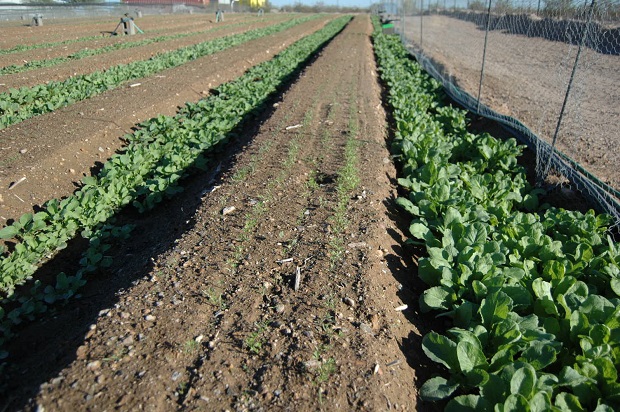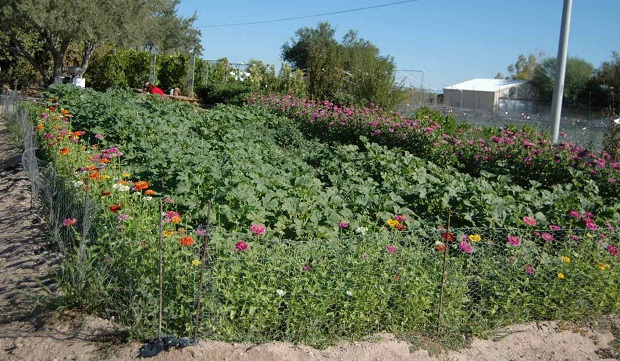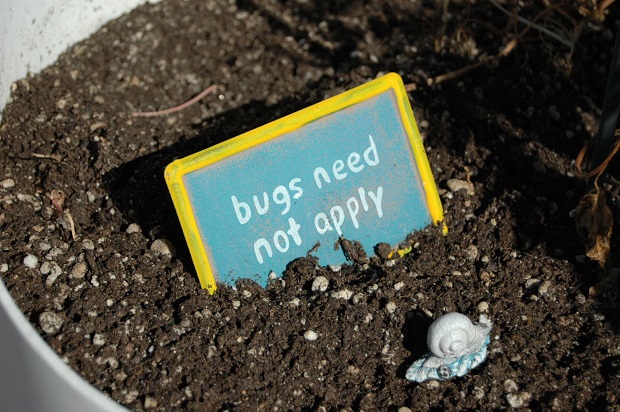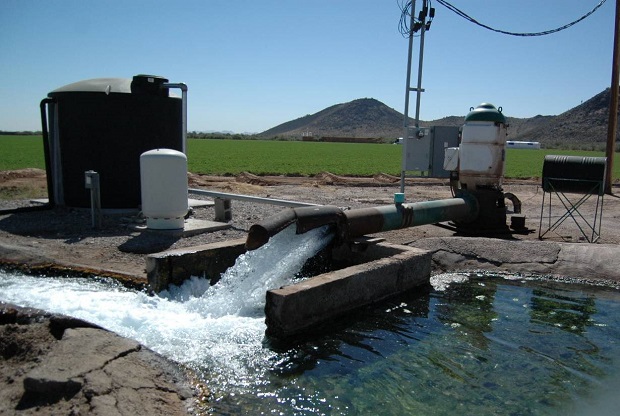In early October my friend Bob Anderson and I visited “Tonopah Rob’s” small 9 acre farm. Rob’s farm is a few miles south of Interstate 10 on the way to Los Angeles about 60 miles west of Phoenix, and within site of the Palo Verde Nuclear Power Plant where my friend, Bob Anderson, works as a refueling supervisor. Bob also lives in Tonopah and has regularly visited Rob’s farm with his family several times over the years.
Over the summer of 2013 at various events and via interviews and networking, Tonopah Rob’s farm was regularly mentioned and I became curious as to how much food could be grown in the desert on a small farm.
Arizona is much more fertile than is commonly known and when water is added to the abundant sunshine you get growth… lots of it. Arizona’s State Seal depicts Mining, Farming and Ranching for good reason http://www.worldatlas.com/webimage/flags/usa/azseal.jpg.
http://cals.arizona.edu/aes/mac/ag-ventures/AZ_AG_facts.htm
Arizona has a $6.3 billion agricultural industry.Arizona has 7,500 farms and ranches across the state.
Beef is Arizona's leading agricultural product.Arizona produces enough beef annually to feed over 4.6 million Americans.
Arizona grows enough cotton each year to make more than one pair of jeans for every man, woman and child in the U.S.Yuma, Arizona is the winter lettuce capitol of the world.
Arizona ranks second in the U.S. in head lettuce, leaf lettuce, romaine lettuce, cauliflower and broccoli production.Nationally, Arizona ranks second in the production of lemons, third in tangerine production, and 4th in the production of oranges and grapefruit.
Arizona apple growers produce 94.5 million pounds of apples each year.
There are 140,000 dairy cows in Arizona with a yearly milk production average of 21,705 pounds per cow.
What interested us about “Tonopah Rob”, Rob Lazzarotto, was that he farmed “Naturally”. We like to call it ‘Virgin Farming’ (how can you screw with food and still call it ‘Virgin’?), the term “Organic” now means whatever various levels of government says it means. The redefining of ‘organic’ by the government and corporate food production so angered Rob that he changed all of his promotion material and made it clear that he farmed using a much higher standard. He almost doubled the size of his small farm with the investments made by his customers in future production and now he supplies food for thousands of families.
http://tonopahrob.com/about/
“Originally, the intent was to farm using purely organic methods. Unfortunately, though, as large corporations and the federal government became involved with organic certification, small farmers such as me were being priced out of getting the “certified organic” label. A small farm must now pay between $400 and $1,400 per crop for certification, annual fees, plus the cost of the inspection which includes travel expenses for the inspector.
Growing everything myself, the produce sold at my farm stand is chemical-free and better than organic. I use NO pesticides of any kind, NO insecticides, ZERO antibiotics, NO chemical fertilizers, and absolutely NO genetically modified organisms. Certain sprays and soaps are allowed in organic farming, but at Tonopah Rob’s Vegetable Farm I practice an all-natural method using beneficial bug warfare, green compost, natural fertilizers, and companion planting as my strategy and line of defense.
I employ thousands, possibly millions of beneficial insects on my farm. Over two-million lady bugs have been released here, as well as thousands of praying mantis, over twenty-thousand green lace wings, and countless wasps. Bees, spiders of all kinds, and even scorpions make up part of the troops. Other reinforcements such as lizards and whiptails, frogs, toads, snakes and iguanas patrol day and night, gobbling up bad bug intruders. Hawks and roadrunners help keep sparrows, quail and larger insects away from my lush mustard and turnip greens.”
Donna called Rob and scheduled an interview for the radio show. Bob Anderson was in studio as well and we asked if Rob would provide us a tour http://www.freedomsphoenix.com/Media/142403-2013-09-26-09-27-13-pepe-escober-rob-lazzarotto-aka-tonopah-rob.htm. Rob agreed but made it clear that this was a very busy time for him so we’d need to come early and be on time (farmer’s hours).
Bob and I spent at least 3 hours with Rob, and Rob agreed that he would host a gathering of FreedomsPhoenix readers and Radio Show listeners from 10am-2pm October 26th 2013 and try to get in two tours of his entire farm. The following weekend (Saturday November 2nd) was the grand opening of his retailing from the farm for the 2013/2014 season that would go well into June (he vacations in late July… TOO HOT!)
This is a very busy time for Rob but we promised to be prompt and that the attendees would be attentive, eager and would follow his instructions.
It was a very pleasant event, and the children were very well behaved and engaged. Donna scolded me for being so serious and focused on keeping the group tight and making sure everyone could hear etc. “I thought all of this effort was about the children Ernie”… Ouch!
All of the kids were great, and their parents were very mindful of them being well behaved. But they were just having fun and enjoying a beautiful day on the farm and didn’t need any direction other than warnings to not face off with an adult male turkey, don’t anger the bees, and to hold their questions until Rob was finished talking at each of the stations. The children were very excited and that added to the fun.
Rob was obviously enjoying himself, too. But we had another group of people that desired a tour and I took a few, and when Rob finished he took another group after the first group left. My only regret was that I didn’t get to talk to any of the new faces and didn’t get to make new friends or to let them know how welcome they were and how appreciative I was that they came and brought their children. We listeners and readers traveled from as far as Las Vegas and Los Angeles to visit the farm with us.
We also printed up nice brochures from FarmMatch.com for all that attended and left a stack for Rob to distribute at his retail stand when he opens.
The following photos are from both visits that I made. That’s why Rob has a Blue and a Red shirt in the photos.
The entrance to the farm hides a lot of what goes on behind the farm house and this is what most visitors see:
Rob lives in this comfortable home on the farm. There are 3-5 full time employees but Rob says he needs 3 times that many at least during the growing season. He is always looking for good employees but he drug tests and will not allow smokers to touch the plants (Tobacco Mosaic Virus destroys many types of vegetables… he showed us where this infection started from someone that wasn’t honest about their smoking and it is devastating to a class of plants called ‘Nightshades’ �" Potatoes, Tomatoes, Peppers, Eggplants… it’s a long list):
Near the house is where the turkeys hang out. Our turkeys are about 2/3rds this size and are 3 months old. These are full grown females:
And here are the males:
Rob treats most of the turkeys as pets and has names for them. Our turkeys are destined for Thanksgiving Dinner but I do like their temperament and they are very friendly to everyone:
The farm has over 300 chickens and Rob does a good business selling organic eggs. He spend a great deal on the natural feed that he has shipped from Montana. Rob focuses growing food for humans and not the chickens. Grains are better bought from Montana in his opinion:
The initial soil preparation is done with a small tractor but the tending and harvesting is all done by hand:
Tonopah Rob’s ‘backyard’:
This Pomegranate tree is shielded with bird netting. We have a Pomegranate tree… it Must be shielded or you are just feeding the birds :):
This simple green house is where some of the plants get their start:
When Rob expanded his farm last year it was mandatory that he buy a small tractor to prepare the fields for planting and to plant the seeds. The rest is done by hand:
Donna and Gary and Verda worked a plot here on our little 2 acres that was about 20% this size and it was almost a full time job for months… I wouldn’t even try being a farmer without a tractor. I happen to price the very tractor that Rob Has and with all of the attachments it’s about $17,000 to $25,000 (which model and how many attachments):
The tractor pulls another attachment that plants the seeds and covers them. These are the lines on top of the mounds. Since Rob doesn’t use the tractor after this step he can then plant ‘companion’ plants in the trough. After years of experimentation, Rob has determined wich combination of planets benefit each other through nutrition and the types of insects they attract. Rob calls it “Bug Wars” and it is how he is able to grow very green and lush plants without chemicals. Even though flowers aren’t sold, as far as I know, they are grown to attract certain beneficial insects and then adorn customer’s baskets (next 3 pictures):



The sections measure about 18 feet wide so that 20 foot sections of Bird Netting can stretched across to prevent the young leaves from being eaten by the many birds that would love the opportunity. Rob has just started using 1-2” wide Mylar Bird Tape, http://www.gemplers.com/product/R40703/Bird-Scare-Flash-Tape-Red-Silver-1-x-290?gclid=CIjR1riOxboCFS9eQgodTSIAIQ&sku=R40703&CID=25SEPLA&ci_src=17588969&ci_sku=R40703&ef_id=UMoTxwAAABDk8y@Q20131102030143s that is reflective on one side and colored on the other, that he attaches to rebar about 3-5 feet above the ground and spaced about 10-12 feet apart. He is very pleased with the early results and this could save him many thousands of dollars a year (Bird Netting is one of his biggest costs on the farm).
Rob has discovered that the quail have learned to land on the netting at this stage of growth and wait for their friends to arrive until enough of them weigh down the netting so that they are able to reach the plants,… and the feast begins (next 2 pictures):
After the plants get large enough and have developed their own chemical defenses, birds are no longer a threat and the netting is rolled up (next 2 pictures): 
Plants that require a lot of water like lettuce, create way too many weeds to deal with naturally. Some crops allow for the burning of the early weeds with a propane torch that doesn’t harm the crops that come up later. But for other plants Rob uses biodegradable Bark Paper that comes in 300’ rolls. He may spend hundreds of dollars covering a field but the savings in water and labor is worth it without having to use chemicals (next 3 pictures):
Some plants can be watered using a sprinkler system, and some need to be irrigated. This is an irrigated field. Rob has several of these small plots that he uses for experimentation and they each have names (I don’t remember the names of these two) (next 3 pictures):
Here is a good example of Rob bordering one crop with another to repel one insect with another, or often the very scent of particular plants are a repellant. I see lots of Basil on the edges. And depending on the general direction of the wind, Rob will plant Sunflowers on the correct side of the field (I can’t remember if it is up or down wind) so that “assassin” bugs are attracted so that the bugs attracted to certain crops are met with lethal force. The bug pictured here is dead, a victim in the Bug War (next 3 pictures):



Bees Bees Bees. Rob has several bee hives around the property. One is Africanized, One Italian, and another honey bee I can’t remember. The African bees attack when you take their honey and can be a pain in the ass and very dangerous for several days after being robbed. But after a couple of years, they mate with the other breeds and calm down. But several Turkeys and Chickens were killed and humans stung before the aggressive bees began to chill out. The new wooden hive is suppose to attract a specific type of bee… and it looks nice in the meantime.
But they are very productive. Rob told us that one colony produces over 300 pounds of honey a year!... Wow! we’re getting some bees after we visit beekeeper Dee Lusby in a couple of weeks in southern Arizona (next 4 pictures):
‘Raised Composting” is new to Rob and I don’t know what made him think to try this, but he discovered that palm fronds don’t decompose very well and the compost doesn’t fall through the chicken wire as he had first hoped due to the palm fronds. But he did discover that when he waters the composting material, it creates a “tea” that feeds the lemon tree. This lemon tree is 3 times bigger than it’s 2-3 year old siblings not fertilized by this method.
Rob was so impressed that he has started experimenting with this sort of ‘tea composting’ in other test fields (next 3 pictures):
I think I remember Rob telling us that there are only 4 grapevines here, and that one fence line here produced over 300 pounds of grapes. He sold many bunches and made jam out of the rest:

Rob has 3 wells on his property that supplies all of the water that he can pump and use (zoned agricultural… unlimited water), and he spends only $500 in electricity a month to power all of his wells, his home, and the farm. The well pictured here is down the street a ways on an industrial farm. This well is pumping out water every time I drive by it when I visit Bob less than a mile from here. The ‘ocean of water’ in this area is also on a volcanic plume and depending on where you are, the water ranges from about 85 to 105+ degrees Fahrenheit. Less than a mile from here is a Hot Springs where you can go and soak in several hot tubs made of stone and concrete with beautiful sunset views. The water is also channeled to grow privacy bamboo, and the entire complex is outdoors but creative planning allows for great views and clothing-optional privacy:

On the other side of the road from the industrial farm I could see bee keepers transporting bee colonies for pollination of the crops. The Collapse of Bee Colonies is a very big concern for many industrial bee keepers and we hope to understand a lot more when we visit 6th generation bee keeper Dee Lusby later this month. But from interviewing her and talking to other farmers and keepers, it seems I might understand a possible solution… don’t be mean to bees :)
Bees are transported a very long ways, all of their honey is taken, and they are feed High Fructose Corn Syrup and other chemicals and people wonder why it is that they leave. They don’t die… they just leave…. Ahhhh Duh. “I have wings… and you’re a dick. I’m outta here”:


